Name
Vilnius is the Lithuanian name of the town and rather pronounced like "Velnyus". The town has many names - the German name is Wilna, which is of course not very often used today. The Polish name version is Wilno, the Jewish (Jiddish to be more exactly) name is Wilne. In Russian, the name is spelled Вильнюс (Vil'nyus). The name might derive from the small river Vilnia which is emptying into the Neris in Vilnius.
Location

| ||
| Vilnius |
Vilnius is the only capital in the three Baltic Seas which doesn't border the Baltic Sea. The town is located in the very East of Lithuania - the border to →Belarus in the east is less then 40 km away. The area around the town is rather hilly and mostly covered by large forests. The river Neris crosses the city centre before it empties into the river Nemunas (Memel) at the city of Kaunas . Vilnius is the centre of the Vilniaus Apskritis (Vilnius District). This district again is part of the administrative unit and cultural region of Aukštaitija (Upper Lithuania).
Population
According to the census of 2001, Vilnius has some 540,000 inhabitants. The share of Lithuanians is - compared to the rest of the contry - rather low. Only 58% are Lithuanians, followed by almost 19% Polish, 14% Russians and Belarusian, Ukrainian, Jewish and many other minorities.
Orientation

| ||
| The modern Vilnius north of the river Neris |
Same as →Riga and →Tallinn, Vilnius' main claim to fame is the well preserved, beautiful otd town. But there's a big difference to the other two capitals: the typical Hansa atmosphere is missing. The Stotis (train station) lies in the south of the city, with the large Autobusų Stotis conveniently located next to the train station (to the left when standing in front of the train station). The square in front of the station is also an important trolley bus station.
The Senamiestis (old town) starts some 500 metres north of the station and stretches all the way to the banks of the larger river Neris. From north to south, the old town is 1.5 km long. To the east, the old town ends at the small river Vilnia, in the west at the long Pylimo St. - one of the main streets of Vilnius. From the east to the west the old town is 1.2 km wide. This means that everything is within walking distance. Large parts of the old town wall have disappeared over the centuries, so it's not always obvious where the old town ends and the new town starts. Especially in the west, where the old town borders the somehow newer yet not modern Nauja miestis (new town). The real modern, vibrant Vilnius can be found north of the river Neris. The area south of the train station on the other hand mainly consists of rather dull residential areas.
History
Vilnius was already founded with the purpose of making it the future capital of gradually expanding Lithuania. The main reason for choosing the place was probably the somewhat hidden, easy to defend location. Grand Duke Gediminas was the one who ordered to build a town here in 1316, and seven years later - as planned - it became the capital of Lithuania. Later on, during the Polish-Lithuanian Union, the town grew bigger and became an important centre not only of trade and administration but also of the Catholic church and Judaism. Because of the latter, the town was often dubbed Jerusalem of the North. In 1579, the first university was founded. But at the same time, the political importance of Vilnius started to crumble. Later, the town was about to become one of many Polish provincial towns.
After many more or less peaceful centuries, the Swedes invaded Vilnius 1702 during the Nordic War and destroyed wide parts of it. As a result of the Treaty of Nystad, Vilnius fell to Tsarist Russia and this shouldn't change until 1915. After that, Vilnius' history became turbulent: First, Germany occupied the town. And left three years later. Lithuania announced its independence, making Vilnius its capital, , but already in 1920 the Polish army crossed the border and took Vilnius. In 1939 again, Germany occupied →Poland, giving Vilnius the chance to be a part of Lithuania again. But only until 1941 when Germany invaded one Baltic state after the other. Ghettos were established and the majority of the Jewish community later deported and murdered - either at mass executions near the capital or in one of the annihilation camps.
In 1944, the Red Army captured Vilnius. For the first time in its history, Vilnius became a communist town. And, until 1990, the capital of the Socialist Soviet Republic of Lithuania. Unfortunately, many of the old buildings in the historic centre were disregarded and started to dilapidate. After declaring independence again in 1990, Vilnius once again became the capital of the country - marked by a sad incident. During the so-called Bloody Sunday, Gorbachev gave the order to tank commanders to stop a demonstration in Vilnius. As a result, 14 protesters were shot dead or crushed by the tanks near the TV tower.
Things have changed ever since. Most parts of the old town have been restored - and so the old town was even declared UNESCO world heritage in 1994. Since virtually everyone could suddenly enter the country (before, most of Lithuania was off-limits for foreigners), the number of foreign visitors jumped to unseen numbers. Besides its role as a popular travel destination, Vilnius is also important as a place of pilgrimage and the seat of the Catholic archbishop.
Getting there / transportation
For detailed information on how to get to Lithuania and Vilnius see →Lithuania travel information. As already mentioned above, Vilnius' old town isn't extremely large and bus and train station aren't far away from the centre, so for most visitors there's no need for public transportation (actually there's not much public and other transportation in the old town at all). However, there are busses and trollley busses. Tickets should better be purchased in advance - at kiosks for example. A single ride costs 0.80 Lt. Tickets can be bought on board, too, but they are more expensive. A 24 hrs ticket costs 4 Lt and is a good bargain.
The old town of Vilnius offers an amazing contrast to →Riga and →Tallinn. Tallinn is very elegant, sometimes even posh but also somewhat menacing in its appearance. Riga on the other hand offers typical Hansa league flair but also countless art noveau buildings and a distinctive nightlife. But Vilnius is a very relaxed, laid back capital with a very special atmosphere. While Riga and Tallinn are characterized by a strong German influence in history - and therefore in its buildings, too - Vilnius is widely missing German elements. Vilnius' certain atmosphere can be enjoyed everywhere in the Senamiestis (old centre of the town) , which has been entirely declared UNESCO world cultural heritage. When approaching from the train stration, the old town starts right behind the Aušros Vartai (Gate of Dawn). Before the gate - a large, noisy and unattractive crossing. Behind the gate: Another world, very baroque and full churches and magnificent buildings but also with a network of tiny alleys.
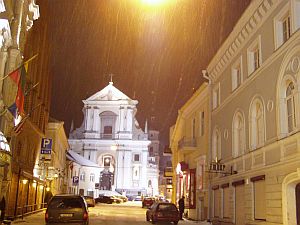
| ||
| Church of Holy Theresa |
The Gate of Dawn was one of altogether nine gates surrounding the old town, but it's the only gate that remained. Large parts of the city wall vanished as well. Only in the south east of the old town, more or less well preserved parts of the wall can be found. Right behind the long gate starts the Aušros Vartų (Gate of Dawn street?). And that's where the sightseeing starts: Soon to the right there's the small but fine Šv. Teresės Bažnyčia (Church of Holy Theresa), which was rebuild in the neoclassicist style. Almost kitty-cornered to that stands the next church, called Šv. Trejybės Cerkvė (Church of the Hl. Trinity). This baroque ensemble is now used as a church and monastery by the Unification (also: Union) church. Unification church? This group once tried to find a compromise between the Orthodox and the Catholic church. Orthodox believers who acknowledged the pope so to say. The church was founded as result of the →Union of Brest.
On the right side of the street again, a beautiful dusky pink coloured gate marks the entrance to the Šv. Dvasios Cerkvė (Church of the Holy Ghost). This one is a Russian-Orthodox church and an architectonic jewel. That's by far not it - close to these churches are the All Saints-Church, the Hl. Kasimir church and the Holy Mother Maria-church.
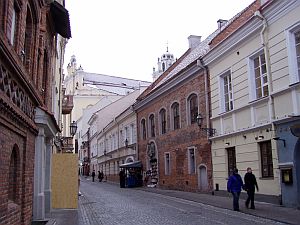
| ||
| Inside the old town of Vilnius |
Further to the north, the Gate street leads straight to the Rotušės Aikštė (town hall square) with the old Rotušė (town hall) at the southern corner of the square. This square isn't very large and nothing really special, but it's surrounded by nice buildings. And it marks the centre of the town. The classicist town hall itself dates back to the 18th century - its predecessor was destroyed during the war. Continue north along Didžioji road, which later becomes Pilies (castle) road and you will get straight to the ĄiKatedros Aikštė (Cathedral square) - nothing less then Vilnius' most famous and most beautiful square. Pilies road is rather narrow and partially used as an open air market. Definitely a nice place for a walk.
Cathedral square hasn't got its name for nothing - the Arkikatedra Bazilika (Cathedral) together with its separate bell tower and knight's monument can't be missed. The cathedral is also known as St Stanislaus Cathedral and doesn't really look like a cathedral - at least not when looking from the back or the side. The present appearance of the classicist structure dates back to the 18th century. Until the 14th century, the same place was characterized by a pagan temple dedicated to the god of thunder. The predecessor of the present building was built at the end of the 14th century. Today, the cathedral is also the seat of the archbishop. The main feature of the cathedral is the distinctive front with three sculptures of Saints on the roof. The building itself doesn't have a tower - therefore the separate Varpinė (bell tower), which is 53 metres high.
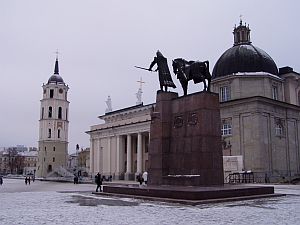
| ||
| Cathedral and bell tower |
South of Cathedral Square, between the cathedral and the above mentioned town hall, stretches the large and beautiful Vilniaus Universitetas - the oldest university of Lithuania, founded in 1579 by the Polish king Stefan Batory. After 1700, Lithuania including Vilnius was ruled by the Russian Tsar and the university became a haven of the resistance. Therefore the university was shut down for almost 100 years. The campus is quite large for an old university and dominated by baroque buildings. Additionally, many precious frescos inside the buildings make it an interesting place to look around. Altogether there are 12 courtyards, a book store, refectories, and the Šv. Jono Bažnyčia (St John church) - a lovely baroque church from the 18th century. Nowadays, some 20,000 students are enroled and create the atmosphere of a university town right in the heart of the capital.
Next to the university - to the west - lies the triangular Daukanto Aikštė (=square) with the large Prime Minister's Residence, which is also used for formal receptions.
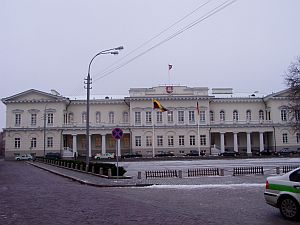
| ||
| The Prime Minister's Residence |
East of Cathedral Square starts the excavation area of an old palace. Right behind it there's a somewhat strange looking hill with a tower on the top. The hill is surrounded by a small park. On the hill stands the Gedimino Pilis (pilis = castle) or at least what's left of it. The name of the castle derives from the Grand Duke Gediminas, whom Lithuania owes its heyday in the 14th century. Before, the duke mainly resided in →Trakai. The location - a steep hill between two rivers - was the perfect place to defend, and so the Duke ordered to build a fortress. This marked the foundation of Vilnius as a town.
At first, the upper castle was erected - later, the lower castle was added. Unfortunately, the fortress was later razed by Russia during the 19th century. The only noticable building left is the not very tall, hexagonal Gedimino Bokštas (Gediminas tower) with the Lithuanian flag on top of it. Visitors can get to the top and visit the museum inside, but during the winter months the facility is closed on Mondays.
At the foot of the hill there's something for rainy days: The Lithuanian National Museum, an archeological exhibition and an arts-and-crafts museum. Behind the hill (north of it) flows the river Neris. On the other side of the river starts the very modern Vilnius (see picture at the top).
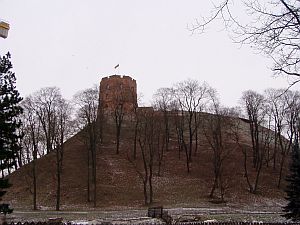
| ||
| Gedimino castle |
When looking from the ruins of the fortress to the east, visitors will notice on the side of the valley of the small river Vilnia another hill with a rather unusual structure on the top of it. This is the Trijų Kryžių Kalnas (Hill of the Three Crosses). Legends say that seven Franciscan monks were murdered here - three of them even crucified. Dedicated to them, three large crosses were built on the hill. The crosses were later removed by the Soviets, but the monument was rebuilt in 1989 and consists of three large, white concrete crosses.
Vilnius is also worth to explore at night. Many buildings in the city centre are lit up - there's no lack of floodlights in the old town. At day as well as at night it's fun to walk around and leave the main roads - there are also many good restaurants and bars to discover in the numerous alleys.

| ||
| Vilnius at night is worth a walk |
A small part of the old town stretches east of the river Vilnia - this rather unspectacular but lovely district is named Užupio (literally: beyond the river) and is known as Vilnius' artists' colony. This part of the town has not been completely renovated and therefore it still offers a certain, authentic charme. When crossing the bridge to the district from the old town, an interesting sign greets the vistor: Užupio Res Publika (sic) - Republic of Uzupio. Similar districts can be found in other European cities as well and are always fun to visit.
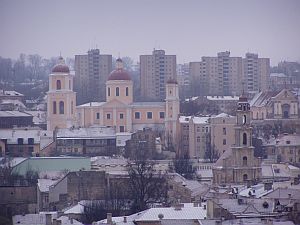
| ||
| New and old lie close to each other in Vilnius |
Apart from the fact that by far not all sights of Vilnius have been mentioned here, it's just fair to name some other attractions - among them the Tarybos Rumai (House of Parliament) far west of the centre, the KGB Museum, the old Šv. Petro ir Povilo Bažnyčia (St Peter and Paul Church) in the northeast with its thousands of statues and statuettes and the Frank Zappa Monument in the newer part of the town - a local radio station had the idea to dedicate a graffiti wall plus a bust to the bard.
The list is not complete. The nice thing with Vilnius is the lack of the feeling one usually gets in a large town, not to talk about capitals. It's a big but very relaxed town with friendly inhabitants - we never got the feeling not to be welcome.
A few kilometres north of Vilnius lies the Europa park - allegedly the geographical centre of Europe. There are some more spots in Europe claiming to be the centre, but culturally and geographically thinking I'm rather tending to trust the Ukrainians, who claim that the European belly must be somewhere near →Uzhgorod.
When it's about day trips from the capital, a visit to →Trakai shouldn't be missed. It's only 30 minutes away by bus and definitely worth a visit.
From dirt-cheap to pure luxury - everything goes. We tried it at the Šopeno Hostel (Address: Šopeno rd, 12-2), which is - at least that's what we'd heard - 25 Lt (€ 7) only per night and person. There are no signs or anything helpful - only a very small youth hostel in a window. It's less then 5 minutes away from the train station. However, the hostel seems to be closed during the winter months.
As an alternative we headed for the Old Town Hostel, which is only two minutes away by foot from the above mentioned Aušros Vartai (Gate of Dawn). The hostel has a community room in the basement with a shared kitchen, free coffee, free internet and a very international crowd (well, half of them were Japanese). An ideal place for backpackers so to say. A bed in a dorm costs 32 Lt (€ 9), a nice and spacious double room with its own shower, toilet and small kitchen costs 100 Lt (some € 16 per person). Since capacities are limited, it's definitely a good idea to book in advance in summer. Address: Aušros Vartų 20-15a (in the backyard, but thanks to the large Youth Hostel sign it can't be missed), Tel.: 05-262 5357. E-Mail: oldtownhostels@delfi.lt, URL: www.lithuanianhostels.org/vilnius/old_town/.
- www.vilnius.lt: Official website of Vilnius with a virtual city guide. Lithuanian and English version.
- http://www.inyourpocket.com/lithuania/vilnius/en/: Very helpful as usual - the online InYourPocket guide - in English.
Do you have or do you know a good website about Vilnius? Don't hesitate, let me know! After checking it, I would love to add it to the link list. You can submit a link by using the →contact form. Note that commercial websites will be treated differently.
©2024 Europe-East.com

 Albania
Albania Lithuania
Lithuania